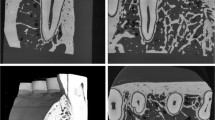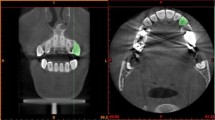Abstract
Orthodontic tooth movements are based on the ability of bone to react to mechanical stresses with the apposition and resorption of alveolar bone. Currently, the underlying biophysical, biochemical, and cellular processes are the subject of numerous studies. At present, however, an analytical description of orthodontic tooth movements including all components of the processes involved seems to be impossible. It was the aim of the present study to develop a mechanics-based phenomenological model capable of describing the alveolar bone remodeling.
Thus, 2 different models were developed. The first is based on the assumption that deformations of the periodontal ligament (PDL) are the key stimulus to starting orthodontic tooth movement. The second supposes that deformations of the alveolar bone are the basis of orthodontic bone remodeling. Both models were integrated into a finite element package calculating stresses, strains and deformations of tooth and tooth supporting structures and from this simulating the movement of the tooth and its alveolus through the bone. Clinically induced canine retractions in 5 patients as well as force systems were exactly measured and the tooth movements were simulated using both models.
The results show that the first model allows reliable simulation of orthodontic tooth movements, whereas the second is to be rejected.
Zusammenfassung
Kieferorthopädische Zahnbewegungen beruhen auf der Fähigkeit des Knochens, auf äußere mechanische Reize mit einem Umbau des Kieferknochens zu reagieren. Die zugrundeliegenden Vorgänge laufen auf biophysikalischer, biochemischer und zellulärer Ebene ab und sind derzeit Gegenstand zahlreicher Untersuchungen. Eine geschlossene Beschreibung aller an der Zahnbewegung beteiligten Prozesse durch ein analytisches modell erscheint aufgrund der Komplexität zur Zeit nicht möglich. Wesentliche Erkenntnisse können jedoch bereits gewonnen werden, wenn es gelingt, ein auf der Mechanik basierendes Simulationsmodell aufzustellen, das die Knochenumbauvorgänge phänomenologisch darstellt.
Zur Beschreibung der orthodontischen Zahnbewegung wurden daher zwei Modelle entwickelt. Grundlage des ersten Modells ist die Annahme, daß der mechanische Schlüsselreiz in Deformationen des parodontalen Ligaments zu sehen ist. Das zweite Modell basiert auf der Hypothese, daß Deformationen der Alveolarwand zum Knochenumbau und damit zur orthodontischen Zahnbewegung beitragen. Diese Modelle wurden in ein Finite-Elemente-Programmsystem integriert, das die Berechnung von Spannungen sowie Deformationen von Zahn und Zahnhalteapparat ermöglicht und hieraus die Bewegung des Zahns durch den Knochen berechnet. Zur Verifizierung wurden bei fünf Patienten Eckzahnretraktionen sowie die klinisch eingesetzten Kraftsysteme genau vermessen und mit Hilfe beider Modelle simuliert.
Die Ergebnisse zeigen, daß das erste Modell eine gute Vorhersage der orthodontischen Zahnbewegung erlaubt, während die Annahme, daß die mechanischen Deformationen der Alveolarwand den Knochenumbau mitbestimmen, die klinische Realität nicht zutreffend beschreibt.
Similar content being viewed by others
References
Abé H, Hayashi K, Sato M, eds. Data book on mechanical properties of living cells, tissues, and organs. Berlin-Heidelberg-New York: Springer, 1996:350–61.
Arramon YP, Cowin SC, Luo G, et al. Strain rate indicated as a remodeling stimulus by animal experiments. Trans Orthop Res Soc 1994;19:280.
Basdra EK. Biologische Auswirkungen der kieferorthopädischen Zahnbewegung. J Orofac Orthop/Fortschr Kieferorthop 1997; 58:2–15.
Bathe KJ. Finite-Elemente-Methoden. Berlin-Heidelberg-New York: Springer, 1986.
Beaupré GS, Orr TW, Carter DR. An approach for time dependent modeling and remodeling-theoretical development. J Orthop Res 1990;8:651–61.
Beaupré GS, Orr TW, Carter DR. An approach for time dependent modeling and remodeling-application: a preliminary remodeling simulation. J Orthop Res 1990;8:662–70.
Bourauel C, Drescher D, Thier M. An experimental set up for the simulation of three dimensional movements in orthodontics. J Biomed Engng 1992;14:371–8.
Bourauel C, Drescher D, Nolte LP. Computergestützte Entwicklung pseudoelastischer Behandlungselemente am Beispiel einer NiTi-Retraktionsfeder. Fortschr Kieferorthop 1993;54:45–56.
Burstone CJ, Koenig HA. Force systems from an ideal arch. Am J Orthodont 1974;65:270–89.
Burstone CJ, Koenig HA. Optimizing anterior and canine retraction. Am J Orthodont 1976;70:1–20.
Carter DR. Mechanical loading history and skeletal biology. J Biomech 1987;20:1095–109.
Cowin SC, Hegedus DH. Bone remodeling I: theory of adaptive elasticity. J Elasticity 1976;6:313–26.
Cowin SC. Continuum models for the adaptation of bone to stress. In: Cowin SC, ed. Mechanical properties of bone. New York: Am Soc Mech Engng, 1981:193–210.
Cobo J, Sicilia A, Argüelles J, et al. Initial stress induced in periodontal tissue with diverse degrees of bone loss by an orthodontic force: tridimensional analysis by means of the finite element method. Am J Orthodont Dentofac Orthop 1993;104:448–54.
Drescher D, Bourauel C, Thier M. Orthodontisches Meß-und Simulations-System zur statischen und dynamischen Analyse der Zahnbewegung. Fortschr Kieferorthop 1991;52:133–40.
Haack DC, Weinstein S. Geometry and mechanics as related to tooth movement studied by means of two-dimensional models. J Am Dent Assoc 1963;66:157–64.
Hart RT, Davy DT. Theories of bone remodeling and modeling. In: Cowin SC, ed. Bone mechanics, Boca Raton: CRC Press, 1989:253–77.
Hall DR, Nakayama WT, Grenoble DE, et al. Elastic constants of three representative dental cements. J Dent Res 1973;52:390.
Huiskes R, Weinans H, Groetenboer HJ, et al. Adaptive bone-remodeling theory applied to prosthetic-design analysis. J Biomech 1987;20:1135–50.
Hurd JJ, Nikolai RJ. Centers of rotation for combined vertical and transverse tooth movements. Am J Orthodont 1976;70: 551–8.
Jacobs CR, Simo JC, Beaupré GS, et al. Adaptive bone remodeling incorporating simultaneous density and anisotropy considerations. J Biomech 1997;30:603–13.
Kobe D, Becker U, Bourauel C. A method of measuring orthodontic tooth movements and positions in three dimensions. J Biomech (submitted for publication).
Koch R, Keß K. Zum Computereinsatz bei der kieferorthopädischen Behandlungsplanung. Kieferorthop 1995;9:35–44.
Koenig HA, Burstone CJ. Analysis of generalized curved beams for orthodontic application. J Biomech 1974;7:429–35.
Korioth TWP, Hannam AG. Deformation of the human mandible during simulated tooth clenching. J Dent Res 1994; 73:56–66.
McGuinness NJP, Wilson AN, Jones ML, et al. A stress analysis of the periodontal ligament under various orthodontic loadings. Eur J Orthodont 1991;13:231–42.
Miyakawa O, Shiokawa N, Matsuura T, et al. A new method for finite element simulation of orthodontic appliance-teeth-periodontium-alveolus system. J Biomech 1985;18:277–84.
Nikolai RJ, Schweiker JW. Investigation of root-periodontium interface stresses and displacements for orthodontic application. Exp Mech 1972;12:406–13.
Nikolai RJ. Rigid body kinematics and single-tooth displacements. Am J Orthodont Dentofac Orthop 1996;110:88–92.
Pryputniewicz RJ, Burstone CJ, Bowley WW. Determination of arbitrary tooth displacements. J Dent Res 1978;57:663–78.
Reitan K. Biomechanical principles and reactions. In: Graber TM, Swain BF, eds. Current orthodontic concepts and techniques. Philadelphia: Saunders, 1975:111–229.
Rho JY, Ashman RB, Turner CH. Young's modulus of trabecular and cortical bone material: ultrasonic and microtensile measurements. J Biomech 1993;26:111–9.
van Rietbergen B, Huiskes R, Weinans H, et al. The mechanism of bone remodeling and resorption around press-fitted THA stems. J Biomech 1993;26:369–82.
Rubin C, Krishnamurthy N, Capilouto E, et al. Stress analysis of the human tooth using a three-dimensional finite element model. J Dent Res 1983;62:82–6.
Spears IR, van Noort R, Crompton RH, et al. The effects of enamel anisotropy on the distribution of stress in a tooth. J Dent Res 1993;72:1526–31.
Tamatsu Y. A measurement of local elastic modulus of buccal compact bone of the human mandible. Jpn J Oral Biol 1994;36:306–29.
Tanne K, Sakuda M, Burstone CJ. Three-dimensional finite element analysis for stress in the periodontal tissue by orthodontic forces. Am J Orthodont Dentofac Orthop 1987;94:499–505.
Tanne K, Nagataki T, Inoue Y, et al. Patterns of initial tooth displacements associated with various root lengths and alveolar bone heights. Am J Orthodont Dentofac Orthop 1991;100: 66–71.
Torzilli PA, Takebe K, Burstein AH, et al. The material properties of immature bone. J Biomech Engng 1982;104:12–20.
Turner CH, Anne V, Pidaparti RMV. A uniform strain criterion for trabecular bone adaptation: do continuum level strain gradients drive adaptation? J Biomech 1997;30:549–54.
Vahey JW, Lewis JL, Vanderby R. Elastic moduli, yield stress, and ultimate stress of cancellous bone in the canine proximal femur. J Biomech 1987;20:29–33.
Vollmer D, Bourauel C, Siebers G, et al. Der Einfluß der Geometrie der Zahnwurzel auf die initiale Zahnbeweglichkeit-eine experimentelle und numerische Untersuchung. Biomed Techn 1997;42:Erg-Bd 2:337–8.
Weinans H, Huiskes R, Grootenboer HJ. Trends of mechanical consequences and modeling of a fibrous membrane around femoral hip prostheses. J Biomech 1990;23:991–1000.
Williams KR, Edmundson JT. Orthodontic tooth movement analysed by the finite element method. Biomaterials 1984;5:347–51.
Wilson AN, Middleton J, Jones ML. The role of the periodontal ligament in bone remodelling. In: Middleton J, Pande GN, Jones ML, eds. Recent advances in computer methods in biomechanics and biomedical engineering. Swansea: Books & Journals International Ltd., 1992:150–8.
Wolff J. Über die Bedeutung der Architektur der spongiösen Substanz. Zentralbl Med Wiss 1869;6:223–34.
Yamamoto K, Toshimitsu A, Mikami T, et al. Optical measurement of three-dimensional tooth movement in orthodontics. Front Med Biol Engng 1988;1:119–30.
Author information
Authors and Affiliations
Corresponding author
Rights and permissions
About this article
Cite this article
Bourauel, C., Freudenreich, D., Vollmer, D. et al. Simulation of orthodontic tooth movements. J Orofac Orthop/Fortschr Kieferorthop 60, 136–151 (1999). https://doi.org/10.1007/BF01298963
Received:
Accepted:
Issue Date:
DOI: https://doi.org/10.1007/BF01298963




